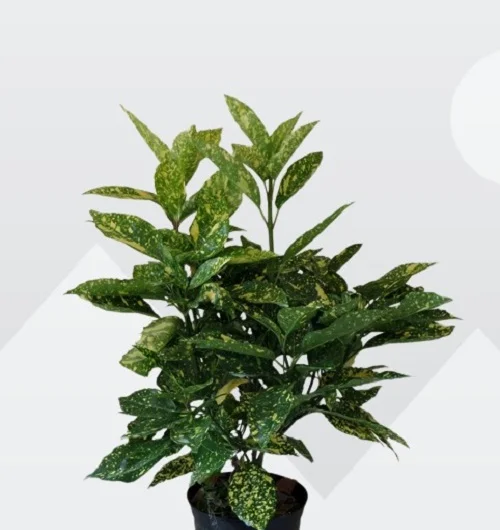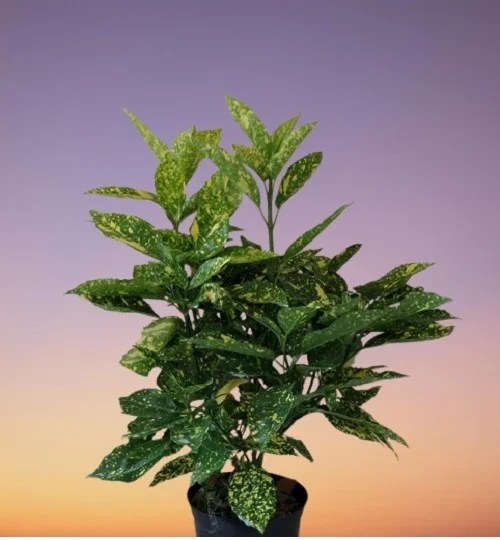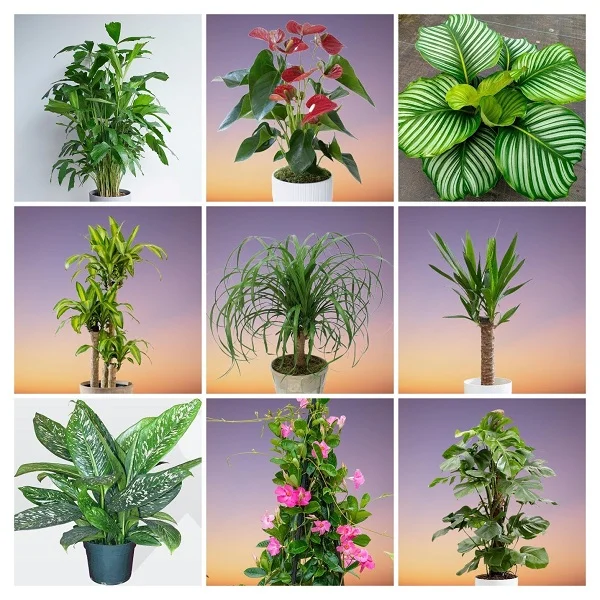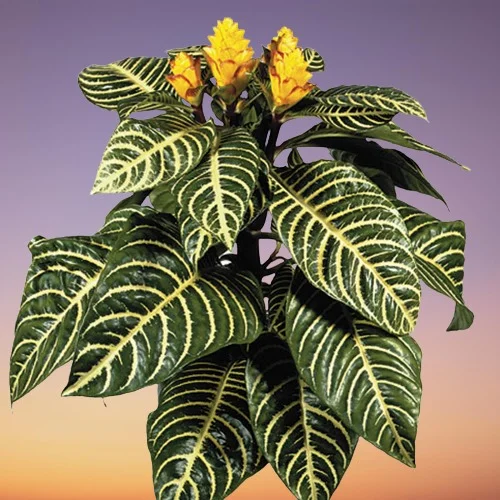Aucuba japonica 'Variegata' (Gold Dust Plant) Care Indoors, Propagation and Problems
Some links in this post may be affiliate links
Aucuba japonica 'Variegata' (Gold Dust Plant) flourishes in bright indirect light, warm and humid conditions and consistently moist, rich, well-drained soil coupled with monthly feeding in the growing season.
Gold Dust Plant also called Japanese Laurel, Spotted Laurel or Japanese Aucuba is a popular plant on account of its striking foliage and ability to adapt to a wide range of growing conditions.
The foliage in Spotted Laurel consists of leathery, glossy green leaves heavily dusted with golden-yellow spots which appear like gold dust and hence the name 'Gold Dust Plant'.
Japanese Laurel is useful for a cool shady spot but is not suitable for the hot or dry locations as serious leaf fall will occur. Its is an excellent plant for adding a splash of color to any plant collection.
Japanese Aucuba are evergreen flowering shrubs belonging to the family Garryaceae but formerly classified in the Aucabaceae or Cornaceae family.

Scientific name: Aucuba japonica 'Variegata'
Family: Garryaceae
Common name: Gold Dust Plant, Japanese Laurel, Spotted Laurel, Japanese Aucuba
Origin
Aucuba species are native to Eastern Asia from the Eastern Himalayas east to China, Korea and Japan.
How big does a Gold Dust Plant get?
Gold Dust Plant can grow to a height of 5-10 feet and 5 feet wide but it can be checked by pruning.
Flowers
Japanese Laurel is dioecious species, producing seperate male and female plants that produce clusters of tiny purplish flowers. If pollinated, they produce bright red berries.
Is Gold Dust Plant poisonous?
Aucuba japonica 'Variegata' is non-toxic to humans and pets. Gold Dust Plants are safe to grow in a home with children, cats, dogs and other pets.
Where to Buy
Are you looking to add these plants to your collection? Vibrant Gold Dust Plants are available online on Etsy (Link to Etsy).
How do you care for Aucuba japonica 'Variegata' indoors?
Aucuba japonica 'Variegata' care indoors entails giving it bright indirect light, average warmth of 15-270C, humidity of 60-70% and consistently moist, fertile, well-drained soil coupled with monthly feeding during the growing season.
Gold Dust Plant care requires regular pruning to keep it neat, to reduce pests and diseases and to encourage a bushy growth. Repotting is needed every 2-3 years when the plant becomes pot-bound. Keep reading for more on these growing conditions and how to achieve them.

Watering
How often should I water a Gold Dust Plant?
To avoid either overwatering or underwatering, both of which are disastrous to the growth of the plant, do not water your Gold Dust Plant on a schedule.
Water your Gold Dust Plant thoroughly in spring and summer and allow the top 1-2 inches of soil to dry out between waterings. Maintain the soil consistently moist but not soggy to prevent yellowing and leaf drop.
Decrease watering in fall and winter as the growth is minimal at this time to keep the soil slightly moist. However, do not let the soil dry out completely to avoid wilting and drooping leaves.
Ascertain that the soil is free-draining and the pot has a drainage hole to prevent the soil from getting soggy to avoid root-rot and eventual death of the plant.
Light Requirements
How much light does a Gold Dust Plant need?
Gold Dust Plant grows best in bright indirect light to maintain the variegation. Place it infront of a large, brightly-lit window. Keep it away from direct sunshine to prevent scorching of the leaves; brown leaf spots.
If the light is too little the leaves will loss the beautiful variegations and the plant may become leggy. Therefore, where the natural lighting is not enough, instal a grow light to supplement it.
Turn the pot regularly to ensure the plant receives light on all sides for uniform growth and prevent leggy growth.
Temperature and Humidity
Aucuba japonica 'Variegata' flourishes in an average warmth of 15-270C with a minimum of 120C in winter. Keep it away from drafts as they can negatively affect the growth of the plant.
Gold Dust Plant prefers a high humidity of 60-70%. To elevate humidity, set the pot on a wet pebble tray, use a humidifier or group the plants together. Maintain a good air flow to minimize fungal diseases.
Potting Soil
What is the best soil for Gold Dust Plant?
The best potting soil for Gold Dust Plant is a well-draining, slightly acidic to neutral soil (pH 6.0-7.0). A mix of 50% potting soil, 30% perlite, and 20% peat moss is ideal for this plant.
Fertilizer
What is the best fertilizer for Aucuba japonica 'Variegata'?
Feed your Aucuba japonica 'Variegata' with a balanced, liquid fertilizer every 4 weeks during the growing period (spring and summer). Avoid too much fertilizer, as it can cause leaf burn.
Do not feed during the cold season (fall and winter) as growth is minimal at this time, therefore, the plant does not need it.
Pruning & Maintenance
How do you prune Gold Dust Plant?
Pruning Gold Dust Plant involves:
- Removal of yellow and dry leaves leaves to maintain the plant neat and to reduce chances of disease and pest infestation.
- Cutting back the plant at the beginning of the growing period (spring) to control the height and encourage a bushy plant. Use a sharp, clean pair of pruning scissors to minimize contamination.
Occasionally clean the leaves by damp-wiping with a soft cloth to get rid of dust as well as discourage pest and disease infestations.
Repotting
Repot your Aucuba japonica 'Variegata' at the beginning of the growing season (spring) every 2-3 years or when it has become pot-bound.
Repot into a pot one size larger that has a drainage hole to prevent the soil from getting soggy to avoid to root-rot. Check out these pots with drainage holes on Amazon.
Top dress the large Japanese Aucuba at the beginning of the growing season by replacing the top 2-3 inches of soil with fresh potting soil.
Aucuba japonica 'Variegata' Propagation
Aucuba japonica 'Variegata' (Gold Dust Plant) is propagated from stem cuttings at the beginning of the growing period (spring to early summer) when the plant is actively growing. The stem cutting can be rooted either in soil or in water.
1. Gold Dust Plant propagation from stem cuttings in soil
- With a sharp, clean knife or scissors, take a 4-6 inches stem cutting from a healthy plant. Ensure the cutting has 2-3 leaf nodes as this is where new growth will come from.
- Strip off the lower leaves and retain at least 2 leaves on top.
- Dip the lower cut end of the cutting in a rooting hormone to hasten rooting.
- Select a small pot (6-8 inches) with a drainage hole to prevent the soil from getting soggy.
- Fill the pot with a well-draining soil and slightly moisten it.
- Insert 2-3 inches of lower cut end of the cutting in the moist soil while ensuring at least 2 leaf nodes are under the soil.
- Place the set up in a warm, well-lit place away from direct sunlight.
- Maintain the soil moist until the cutting has rooted; rooting should occur in 4-6 weeks.
- Once the new plant is well established, transplant it into a pot one size larger, after which you can begin routine care.
2. Gold Dust Plant propagation from stem cuttings in water
- Take a 4-6 inches stem cutting from a healthy plant with a sharp, sterilized knife or scissors. Make sure it has 2-3 leaf nodes as this is where new growth will emerge from.
- Remove the lower leaves and retain at least 2 leaves on top.
- Coat the lower cut end of the cutting with a rooting hormone to encourage rooting.
- Remove the lower leaves from the cutting and retain some leaves on top.
- Place the cuttings in a jar of plain water or in a propagation station. Ensure that at least 2-3 inches are submerged, but keep the leaves above water.
- Position the set up in a warm spot under bright indirect light and change the water every 5-7 days to prevent bacterial growth.
- Rooting should occur in 3-6 weeks. Once the roots are about 2-3 inches long, prepare to transfer the cuttings into soil.
- Select a small pot and ensure that the pot has a drainage hole to prevent the soil from getting soggy to avoid rotting.
- Fill the pot with well-drained potting mix and moisten the soil slightly.
- Make a hole in the center of the pot. Ensure that the hole is slightly wider than the root base of the new plant.
- Place the new plant in the previously made hole and lightly firm the soil around the base while taking care not to bury it too deep.
- Position the set up in warm, well-lit spot and maintain the soil moist until the plants are well established after which you can begin routine care.

Aucuba japonica 'Variegata' Problems & Remedies
Aucuba japonica 'Variegata' (Gold Dust Plant) problems are dropping leaves, brown leaves, drooping leaves, plant dying, curling leaves, yellow leaves, brown leaf spots, diseases and pests. Keep reading for more on these problems and how to fix them.
Dropping leaves
Why is my Gold Dust Plant dropping leaves?
Your Gold Dust Plant is dropping leaves due to inconsistent watering, soggy soil, dry air, and temperature stress.
How to fix it
Inconsistent watering: Do not water on a schedule. Water when the top 1-2 inches of soil dry out but do not allow the soil to dry out completely.
Soggy soil: Use well-draining soil and a pot that has a drainage hole.
Dry air: To up humidity, set the pot on a wet pebble tray, use a humidifier or group the plants together to create a humid microclimate.
Temperature stress: Keep the plant away from drafts coming from AC units, windy doors, heat sources and others to maintain an average warmth of 15-270C.
Brown leaves
Why are the leaves on my Gold Dust Plant turning brown?
Some of the causes of brown leaves on your Gold Dust Plant are inconsistent watering, soggy soil, and extreme temperatures.
How to fix it
Inconsistent watering: Water when the top 1-2 inches dry out. Never allow the soil to dry out completely.
Soggy soil: Use a pot with a drainage hole and a well-draining soil.
Extreme temperatures: Keep the plant away from drafts emanating from AC units, drafty windows, heat sources, windy doors and others.
Drooping leaves
Why is my Gold Dust Plant drooping?
Your Gold Dust Plant is drooping due to underwatering, hot drafts and direct sunlight.
How to fix it
Underwatering: Water when the top 1-2 inches of soil feel dry but do not allow the soil to dry out completely.
Hot drafts: Keep the plant away from stoves, heat vents and other heat sources.
Direct sunlight: Keep the plant away from direct sunlight or use a light curtain to filter the sunlight.
Plant dying
Why is my Gold Dust Plant dying?
Your Gold Dust Plant is dying due to root-rot which is prevalent in soggy soil. The disease is characterized by yellowing and wilting of the leaves which is rapidly followed by browning and plant collapse.
How to fix it
- Carefully slip the plant out of its pot and inspect the roots.
- Trim brown-black mushy roots and treat the healthy roots with a copper-based fungicidal solution as indicated on the label.
- Disinfect the pot with the fungicidal solution or use a fresh pot to repot the plant in fresh, well-draining soil.
- Do not water the plant immediately; keep it dry for 5-7 days before you can resume watering.
- Use a pot with a drainage hole and well-draining soil to prevent the soil from getting soggy.
- Cut down on watering in fall and winter as growth is slowed at this time; keep the soil slightly moist.
Curling leaves
Why are the leaves curling on my Gold Dust Plant?
Curling leaves on your Gold Dust Plant are caused by low humidity, underwatering and drafts.
How to fix it
Low humidity: Set the pot on a wet peeble tray or use a humidifier to increase humidity.
Underwatering: Keep the soil consistently moist in spring and summer, and slightly moist in fall and winter.
Drafts: Maintain an average warmth of 15-270C and protect the plant from both hot and cold drafts.
Yellow leaves
Why are the leaves on my Gold Dust Plant turning yellow?
The main causes of yellow leaves on your Gold Dust Plant are overwatering, soggy soil, temperature stress, and aging.
How to fix it
Overwatering: Do not water on a schedule. Water only when the top 1-2 inches of soil dry out.
Soggy soil: Use well-draining soil and a pot that has a drainage hole.
Temperature stress: Keep the plant away from drafts emanating from AC units, heat sources, windy doors, drafty windows and others.
Aging: As the plant matures, the lower leaves turn yellow and fall off.
Brown leaf spots
Brown leaf spots on Gold Dust Plant are sunscorch marks due to exposure to hot direct sunlight. Move the plant to a shadier spot or filter the light with a light curtain.
Pests
Common pests in Gold Dust Plant are scale insects, mealybugs and aphids which are mainly found in the young plant but rarely in mature plants.
How to fix it
- Isolate the affected plant to prevent spread to the other plants.
- Treat the affected plant with neem oil or insecticidal soap as per the manufacturers' instructions.
- Regularly clean the leaves by damp-wiping with a soft cloth to keep the pests away.
- Keep the plant well pruned to reduce the hiding and breeding places for these pests.
Conclusion
Gold Dust Plant (Aucuba japonica 'Variegata') is a low-maintenance, shade-loving plant that adds a tropical charm to any space. With the right care; proper watering, indirect light, and occasional pruning, this striking plant will thrive indoors for years.
You liked it? Share on social media.
Related Content
Amazon Associates Disclosure
Homeplantsguide.com is a participant in the Amazon Services LLC Associates Program, an affiliate advertising program designed to provide a means for sites to earn advertising fees by advertising and linking to amazon.com.





